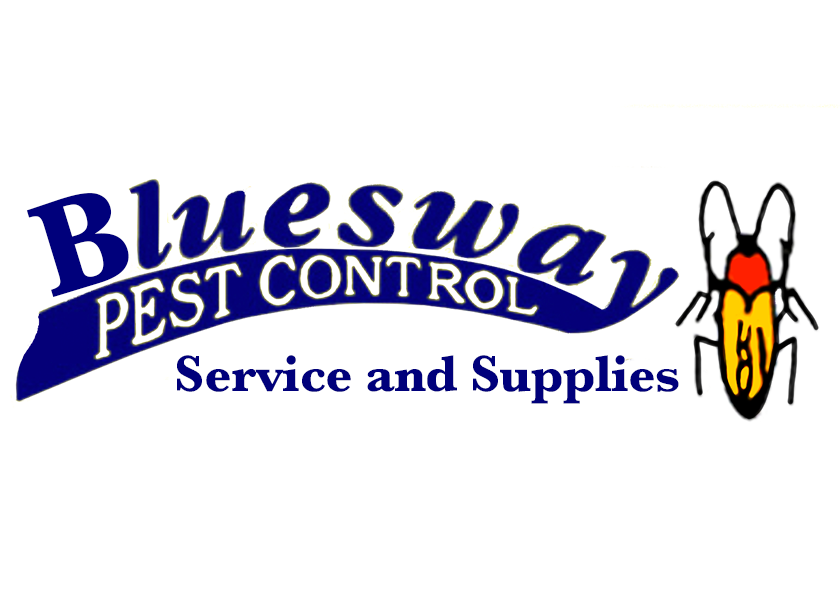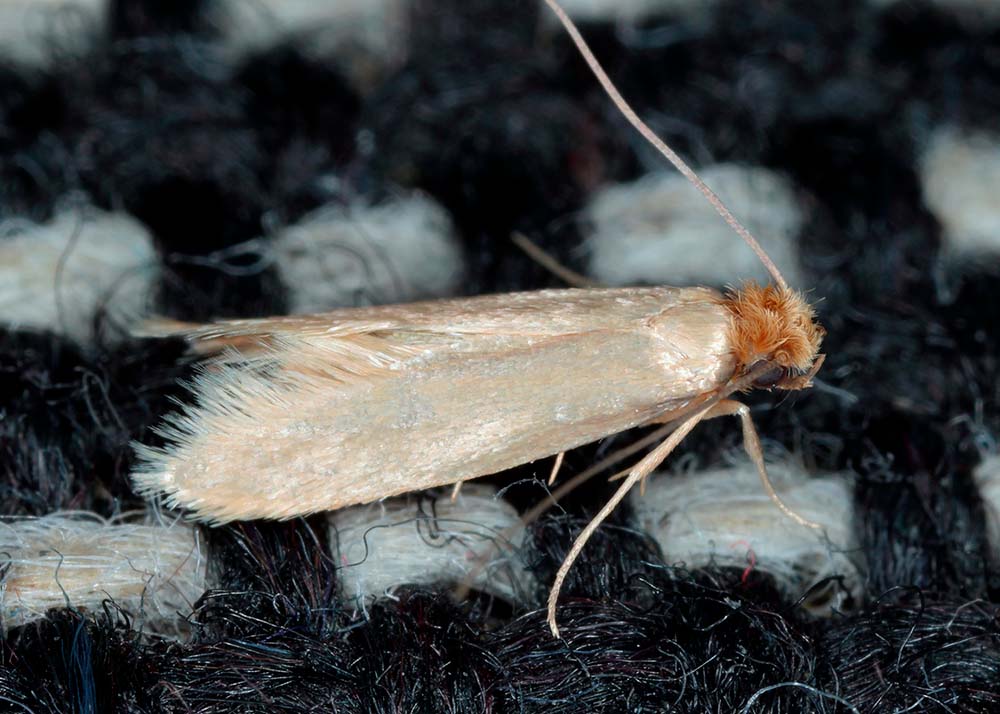Pantry Pest
Identification & Prevention
Indianmeal Moths
These moths are a common pest found in food products. In homes, they may be first discovered flying around your kitchen area. They are also found in food processing plants, grain storage and processing facilities.
The larvae, which look like little worms, prefer to feed on coarsely ground flour and meal, but, commonly feed on whole grains, dried fruit, nuts, chocolate, beans, crackers, biscuits, dry dog food, birdseed, and red peppers. The larvae of this pantry pest produce silk webbing over the surface of the materials upon which they are feeding. The webbing contains large amounts of their frass.

The damage caused by this pest’s feeding is compounded by the presence of this repulsive material. The larvae move into cracks and crevices in the food material, feeding within or near this silken mat.
Indianmeal Moths Life Cycle
The mature larvae often move away from infested materials to pupate in cracks or crevices. This behavior pattern often allows them to be discovered by homeowners.
This pest of stored products is about 3/8 inch long at rest; wingspread is about 5/8 inch. When at rest the wings are folded together along the line of the body. The front half of the fore-wings is a grayish-white color, and the lower half is a rusty red-brown color.
The adult moths usually fly at night and lay eggs on food such as grain, dried food, and especially dried pet food. The life cycle and habits of this pantry pest is similar to other moths infesting stored products. Eggs are laid on or near the food.
A female moth may deposit anywhere from 40 to 350 eggs. After hatching, the small caterpillars begin spinning silken threads in the infested food material. They feed for about two weeks before becoming fully grown. Then, they crawl up to the surface of the food material and often up walls and pupate within a cocoon where the wall meets the ceiling.
The adult (moth) emerges in about 30 days. The entire cycle requires about six weeks and there are from 4-6 generations per year.
Drugstore Beetle
The drugstore beetle also known as the bread beetle or biscuit beetle, is a tiny, brown beetle that can be found infesting a wide variety of products, and is among the most common non-weevils to be found there. It is the only member of the monotypic genus Stegobium.
The drugstore beetle has a worldwide distribution and can be more commonly found in warmer climates. It is similar in appearance to the cigarette beetle (Lasioderma serricorne), but is slightly larger (adults can be up to 3.5 mm in length).
Additionally, drugstore beetles have antennae ending in 3-segmented clubs, while cigarette beetles have serrated antennae (notched like teeth of a saw). The drugstore beetle also has grooves running longitudinally along the elytra, whereas the cigarette beetle is smooth.

What Drugstore Beetles Feed On
As its name suggests, the drugstore beetle has a tendency to feed on pharmacological products, this is from its preference of dried herbs and plant material sometimes used as drugs, e.g. drugstore beetles have been known to feed on Strychnine, a highly toxic herbal extract.
It can also feed on a diverse range of dried foods and spices, as well as hair, leather, books, and museum specimens. It can bore into furniture and in some cases tin foil or sheets of lead. The drugstore beetle is also known as the biscuit or bread beetle since it can happily live on biscuit or bread crumbs.
Clothes Moth
Tineidae is a family of moths in the order Lepidoptera. Collectively, they are known as fungus moths or tineid moths. The family contains considerably more than 3,000 species in more than 300 genera.
Most of the tineid moths are small or medium-sized, with wings held roofwise over the body when at rest. They are particularly common in the Palaearctic, but many occur elsewhere, and some are found very widely as introduced species.
Tineids are unusual among Lepidoptera as the larvae of only a very small number of species feed on living plants, the majority feeding on fungi, lichens, and detritus. The most familiar members of the family are the clothes moths, which have adapted to feeding on stored fabrics.
The most widespread of such species are the common clothes moth (Tineola bisselliella), the case-bearing clothes moth (Tinea pellionella), and the carpet moth (Trichophaga tapetzella); the brown-dotted clothes moth (Niditinea fuscella) despite its name, preferentially feeds on feathers in bird nests.
One remarkable genus is Ceratophaga, whose members feed exclusively on pure keratin in the form of the horns and hooves of dead mammals and even the shells of dead tortoises.
Rice Weevil
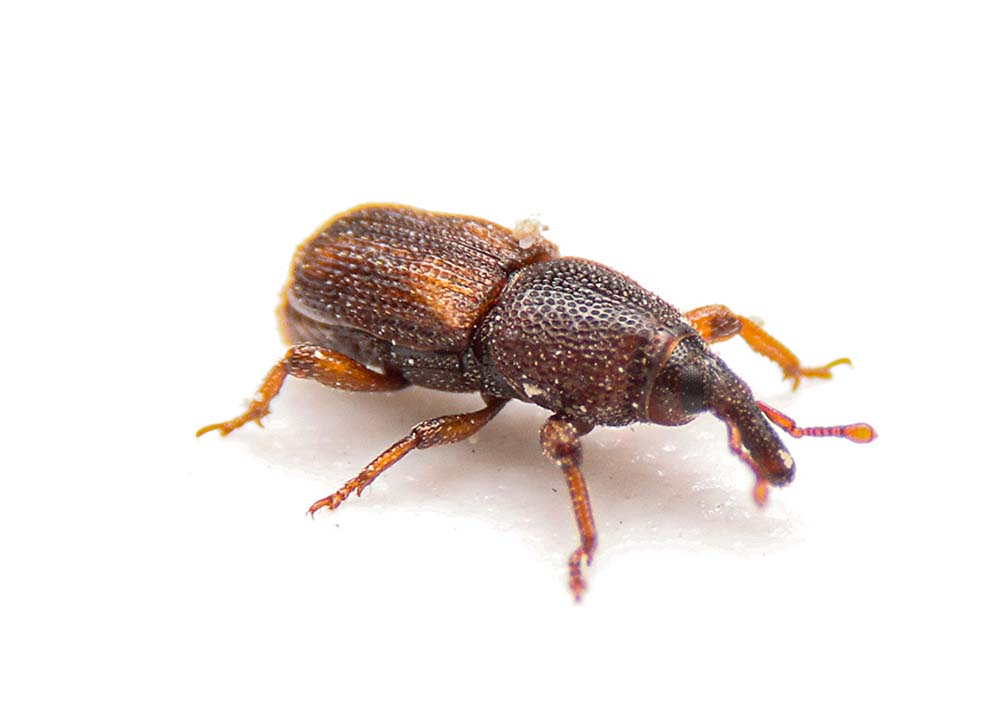
The rice weevil is a serious stored product pest that attacks several crops, including wheat, rice, and maize.
It is recommended to store all foods in glass jars or plastic zip-top bags. Unfortunately, grain weevils (Sitophilus granarius, also called granary weevils or wheat weevils, can chew through paper and plastic packaging.
But how did the weevils get there in the first place? You may want to skip this part if you’re squeamish but we think it’s actually quite fascinating … A female weevil lays an egg inside a grain kernel. (She can do this up to 254 times!) The egg hatches and for one to five months depending on the season, the larva lives inside and feeds on the kernel as it grows. Upon reaching adulthood, the weevil emerges from the kernel to mate – and look for new grains to invade.
We’re kind of amazed to think of this process taking place inside a bag of wheat berries we purchased six months ago and forgot in the back of a cupboard!
That said, we definitely don’t want it to happen again and these are the steps we’re taking to eliminate and prevent grain weevils from our pantry:
Prevent Rice Weevil
- Inspect all grains upon purchase.
- Freeze grains for at least 1 week (or store permanently in the freezer) to kill any eggs.
- Buy grains in small quantities and eat within a reasonable period of time. (We certainly learned our lesson with this one!)
- Store grains in tightly sealed glass, metal, or sturdy plastic containers (not bags).
- Regularly clean pantry cracks, crevices, and shelves.
- Small bags of black pepper placed around the pantry may repel weevils.
Eliminate Rice Weevil
- Discard any infested foods. Grain weevils can bore through plastic and cardboard so inspect everything thoroughly. (We chose to be safe and got rid of everything that wasn’t already stored properly.)
- Vacuum pantry shelves, cracks, and crevices.
- Wipe shelves with white vinegar.
- Dispose of garbage and vacuum bags outside, away from the home.
- Check regularly for reappearance – it may take a while to get rid of them completely.
Flour Beetle
(Tribolium confusum), a type of darkling beetle known as a flour beetle, is a common pest insect known for attacking and infesting stored flour and grain. They are one of the most common and most destructive insect pests for grain and other food products stored in silos, warehouses, grocery stores, and homes.
While confused (and red) flour beetles cannot feed on whole, undamaged grain, they are often found in large numbers in infested grains, feeding on broken grain, grain dust, and other household food items such as flour, rice, dried fruit, nuts, and beans.
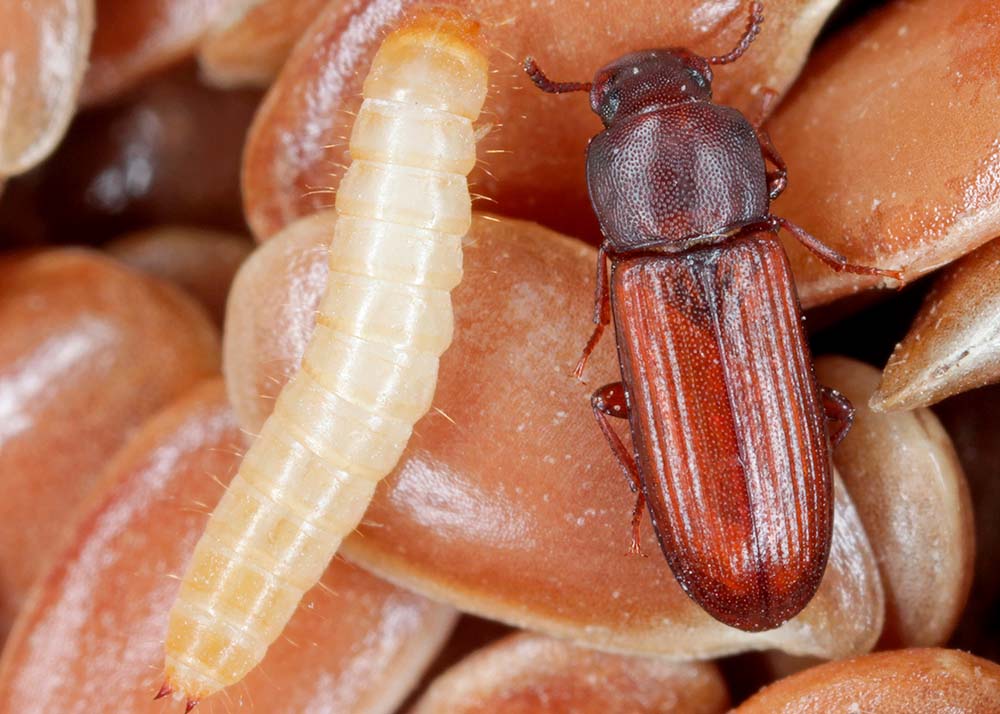
Both types of beetles are often found not only in infested grains, but in crevices in pantries and cabinet, as well. Damage to food is caused somewhat by the beetles’ feeding, but also by their dead bodies, fecal pellets, and foul-smelling secretions. In addition to creating a foul odor, the beetles’ presence encourages the growth of mold.
The United Nations, in a recent post-harvest compendium, estimated that Tribolium castaneum (red flour beetle) & Tribolium confusum, are “the two most common secondary pests of all plant commodities in store throughout the world.”
Sawtoothed Grain Beetle
The sawtoothed grain beetle can be found infesting foods in homes, grocery stores, and food processing facilities around the world. These beetles feed on a variety of products including flour, cereal, bread, pasta, dried fruits, nuts and dried meats.
Their feeding activity not only damages goods, but the presence of sawtoothed grain beetles can also create favorable conditions that lead to mold growth. Sawtooth grain beetles are small, brown, flightless beetles that measure only about 1/10th of an inch in length.
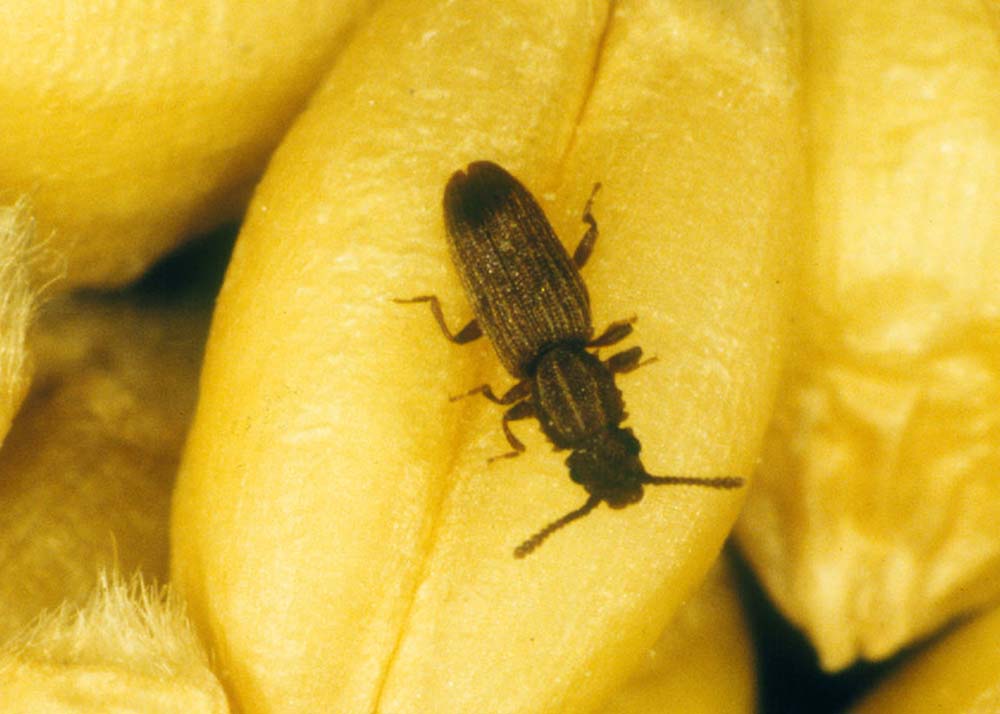
Photo: CSIRO, CC BY 3.0, via Wikimedia Commons
They get their name from the characteristic sawtoothed projections lining either side of the thorax. Their tiny bodies are flattened, allowing adults to easily find their way into food packaging through small cracks and folds. Sawtooth grain beetles live an average of 8-10 months.
Females may lay over 250 eggs that can hatch in less than a week, and can reach adulthood in only a few months. Because of their fast development, sawtoothed grain beetles can produce multiple generations during the warm summer months.
How To Eliminate Sawtoothed Grain Beetle Infestation
Eliminating a sawtooth beetle infestation begins with identifying and eliminating the infested food source(s). Once infested items are discarded, the area should be thoroughly cleaned and vacuumed to remove any eggs, insects, and food debris.
A thorough inspection should be conducted to ensure other items have not been infested. In some cases, chemical treatments may be necessary, and should only be completed by a licensed professional since most infestations occur in areas where food is stored and prepared.
Exterminating Services Estimate
Bluesway Pest Control provides dependable and affordable pantry pest control and exterminating services.
For more information, please contact us today. We will gladly answer any questions or concerns you may have regarding our exterminating services. We can also provide you with a free estimate for our services.
“This is your friendly neighborhood Exterminator. I shopped around and this was the best/Lowest pricing I can find! Excellent service! Any issues, I call and it’s resolved and taken care of. They work with me on payment plans and they will do the same for you! A+ grade!”
Adel O.
Get Started with Bluesway Pest Control Today!
(914) 968-8404
We have a loyal client base in communities like Yonkers, Mount Vernon, New Rochelle, White Plains, Scarsdale, Dobbs Ferry, Eastchester, Port Chester, Rye, and all throughout Westchester, including Rockland County and parts of New York City.

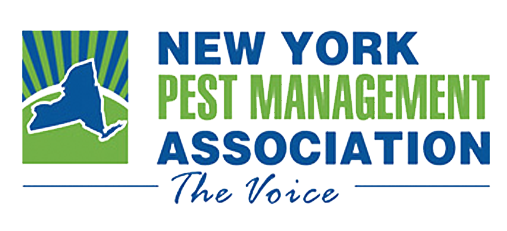





Bluesway Pest Control
320 Saw Mill River Road
Yonkers, NY 10701

Copyright © 2022 Bluesway Pest Control – All Rights Reserved.
